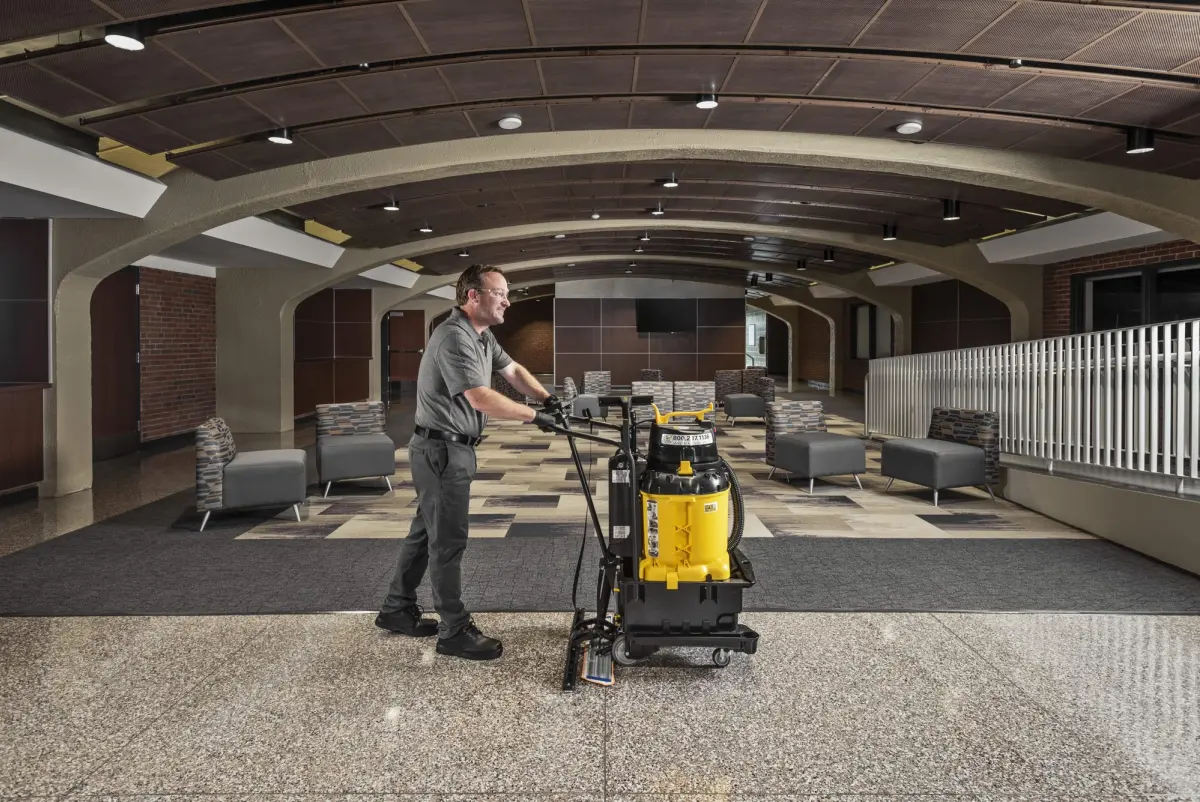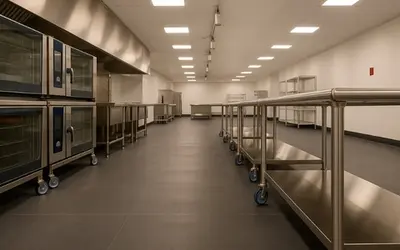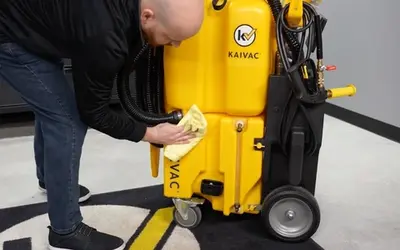The Ultimate Hotel Cleaning Checklist

Cleanliness is key to any hotel’s success. No matter the size of the establishment or economic challenges thrown at the hospitality industry, hotel and resort cleanliness remains a huge factor in attracting and delighting guests. Now with infection control at the front of everyone’s mind, thorough hotel cleaning and creating a hotel cleaning checklist become even more vital for owners, operators, guests and staff.
Cleaning a hotel, however, presents many challenges.
Along with guest rooms, hotels contain a myriad of spaces finished with a multitude of materials and furnishings. Grand lobbies, intimate bars, fine restaurants, bustling coffee shops, gyms, indoor pools, and ballrooms all need attention.
Smaller establishments may not contain as many amenities, but still require five-star upkeep to compete.
This upkeep does not come cheaply. On average it costs between $10 and $16 to clean a typical hotel room. Cleaning luxury hotel rooms cost a bit more, around $20 a room. Housekeeping staff salaries make up the bulk of this expense, claiming about 65% of costs, with the rest going to equipment, supplies and training.
Hotel operators want to maximize these costs while protecting their guests, staff and reputation. This guide will outline different hotel areas and amenities and offer tips on how to keep them clean, safe and sanitary.
Areas covered in this guide include:
- Keeping lobbies spotless and sparkling
- Hotel restaurant cleaning to contain grease
- Fighting mold and mildew in Indoor Pool and Gym areas
- How to clean a hotel room quickly and completely
Keeping Hotel Lobbies Spotless and Sparkling
First impressions start in the hotel lobby. A clean entrance, with spotless glass, fresh looking floors and dust-free furnishings greets guests with the promise of a comfortable stay.
A poorly maintained space, on the other hand, sets the wrong tone and may lead guests to write a poor review. In fact, Hospitality Net reports that a whopping 73.5% of one and two-star reviews contained complaints about cleanliness.
Here’s how to turn a hotel lobby into a showplace.
- Start with the Floors
Heavily trafficked floors take a beating. Protect them from the start with a good entrance matting system that attracts grit and absorbs water. Sweep or vacuum at least twice a day to remove tracked in soils. For large, hard surface lobby floors consider a Kaivac AutoVac. This technology works quickly, picking up debris and wet spills, leaving floors sparkling clean and dry.
- Wipe Down Touchpoints
Door handles, kiosk touchscreens, elevator buttons and luggage carts should be smudge and finger print free. Use a correctly folded, numbered, microfiber towel to shine and prevent cross-contamination.
- Vacuum and Clean Furnishings
Vacuum upholstered furniture with attachment. Clean and sanitize hard furnishings according to manufacturer directions.
Hotel Restaurant Cleaning to Contain Grease
Obviously, food safety should be the focus of every restaurant cleaning job. Foodborne illnesses like E-coli, Salmonella and shigella are no joke and can be caused by poor cleaning protocols. Prevent this by training staff well on food handling and cleaning procedures.
Grease control should also be high on your priority list.
Fat particles from the fryers and grill suspend in the air and accumulate. Overtime they form a grimy film coating everything. Eventually walls, equipment and floors are covered, creating a slip, trip and fall hazard that is hard to remove. Workers then track that grease throughout the restaurant space, creating more mess and more hazard.
Remove grease the right way by:
1. Use a Degreaser
Degreasers are designed to penetrate and break up oils, greases and fats. Read manufacturer’s directions and follow carefully. Wear protective gear as directed. Allow degreaser to dwell for at least 10 minutes before removing.
2. Fully Remove Soils
Loosened grease is still hard to remove as mops and squeegee systems just spread the substance around. Try a vacuum extraction system instead. Tools like this completely remove greasy soils leaving floors clean, dry and safe to walk on.
Fight Mold and Mildew in Indoor Pool and Gym Areas
Amenities like indoor pools and on-site gyms attract families and business travelers alike. Vacuuming and touchpoint maintenance are important maintenance tasks but mold and mildew present the biggest challenges for these warm, moist areas.
The fungus that creates mold can cause illness, like rashes, headaches and more in healthy people. Emitting a musty, easily identifiable smell, mold grows in pool and gym areas, forming on dust, grime, soap scum and food scraps. Getting rid of mold and mildew can be difficult.
Prevent mold and mildew from forming by:
1. Ensure Proper Ventilation
Humidity control starts in the design phase. Pools and gyms should have a ventilation system that keeps relatively humidity below 70% to inhibit mold growth.
2. Remove Standing Water
Mold and mildew need moisture to thrive. Freshly-mopped floors add more moisture to the air, encouraging mold and mildew to grow. Remove water with a Spray-and-Vac instead. This tool leaves floors clean and dry while cutting labor, chemical and equipment costs.
How to Clean a Hotel Room Quickly and Completely
Cleaning a hotel room completely takes time, about 45 minutes according to Alliance Online. This may seem rigorous, but consistently cleaned rooms will burnish your hotel’s reputation in a difficult market. After all, hotels don’t only compete with other hotels. Private accommodations booked through sharing apps like AirBnB are eating into profits.
Consistently clean rooms should delight and reassure guests, setting your hotel apart from the pack.
To ensure a great stay cleaning staff should:
1. Dust from High to Low
Woodwork, picture frames, windows, vents and doors should be dusted daily. Pay attention to furniture, lampshades and heating/air conditioning units as well.
2. Vacuum Carpet
Spot remove stains. Note any repairs that require attention.
3. Make Bed and Shine Mirrors
Use fresh linens and bed spreads. Remove fingerprints, dust and dirt from mirrors.
4. Clean Touchpoints
Clean remote controls, telephones, door knobs and light switches. Don’t forget to empty trash.
Best Practices for Cleaning Hotel Restrooms
Restrooms sit at the heart of hotel cleaning. Guests want their hotel tub, toilet and shower fresh, sparkling and cleaner than their accommodations at home. There should be no dirt, grime, mold or hair anywhere in a hotel restroom.
Instruct staff to:
- Clean Shower and Bath – Staff should take care to dry surfaces to inhibit mold growth.
- Clean Sinks, Counter and Mirror – Pay attention to touchpoints like faucet taps and towel rails. Remember to dry surfaces to prevent water spots.
- Swab Toilet – Use approved cleaning chemicals and follow directions carefully. Clean and dry exterior and seat.
- Scrub Tile and Grout on Walls and Floors
Grout can be difficult to clean and may harbor foul-smelling bacteria. Be sure to remove soils completely for the freshest results.
Achieving sparkling clean restrooms is easier said than done. Hotel housekeepers have a lot of ground to cover. This means they need fast-working, flexible tools that clean and dry every restroom surface. Mops, buckets and rags are slow and laborious to use, making them impractical for cleaning lots of restrooms.
Equip them with a Kaivac No-Touch Cleaning System instead. This tool removes contaminants from hard surfaces and grout, cleaning 30-60 times better than cotton or microfiber mops. They also work faster, saving valuable employee time.
Keeping a hotel clean is hard work but there are tips and tools to lighten the load. Check out other ways Kaivac can help keep your establishment fresh, inviting and clean.
Related Posts

Floor Cleanliness and Food Safety Scores
Poorly maintained floors are unsafe and unsanitary. They hold standing water, harbor pests, and cause slip, trip, and fall accidents. Here’s how to improve floor care and your food safety scores.
Read more
Preventive Maintenance for Your No-Touch Cleaning® System
Your Kaivac No-Touch Cleaning system makes restroom maintenance fast and easy. Keeping your No-Touch Cleaning system in good working order is also fast and easy. Kaivac makes performing preventative maintenance and troubleshooting potential issues simple. No special equipment or technical expertise required.
Read more
Beyond the Restroom: Kaivac for Fast, Easy, and Complete Kitchen Floor Care
You already know and trust Kaivac for restroom care. Our No-Touch Cleaning® systems make the unpleasant task of servicing restrooms fast, easy and complete. But did you know Kaivac has cleaning machines for every kind of floor?
Read more